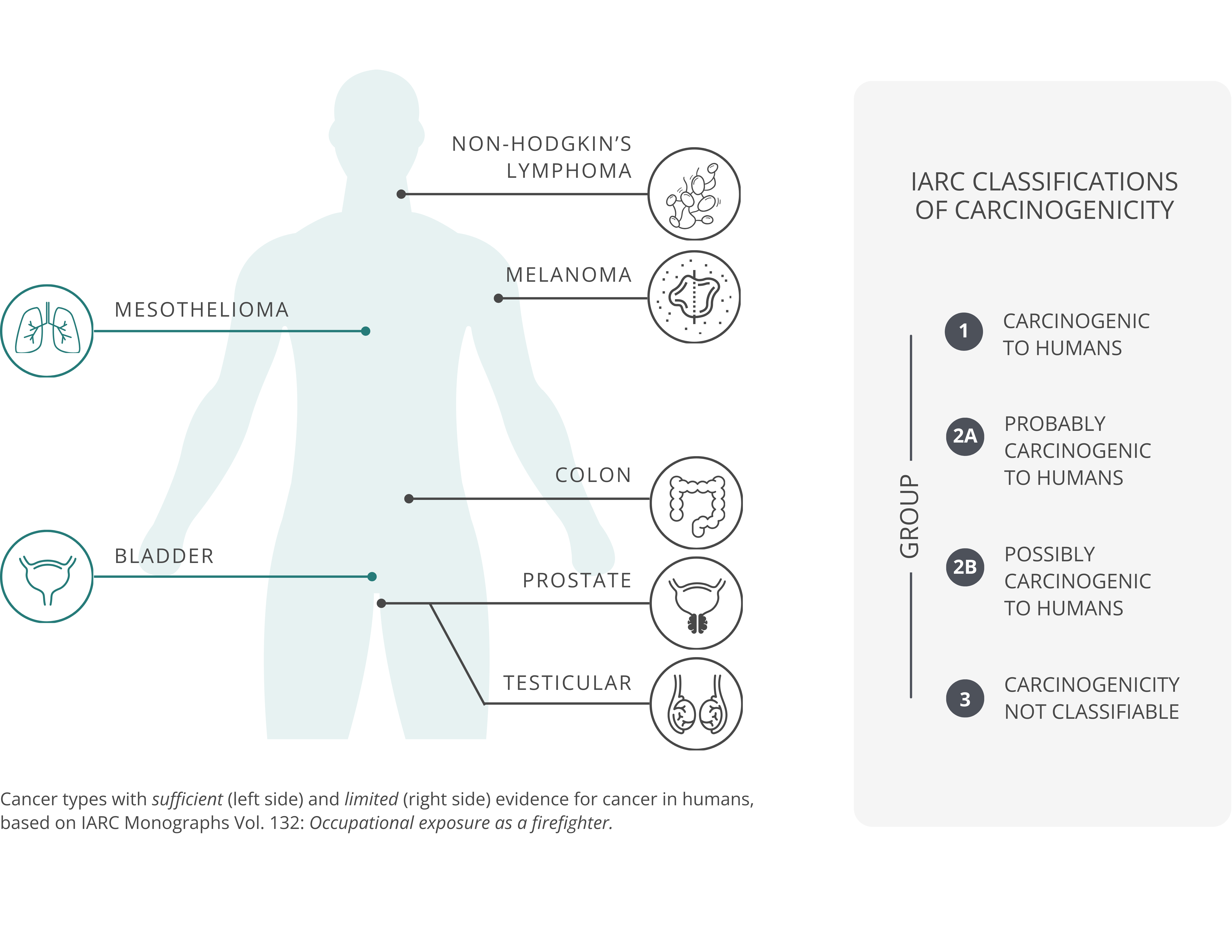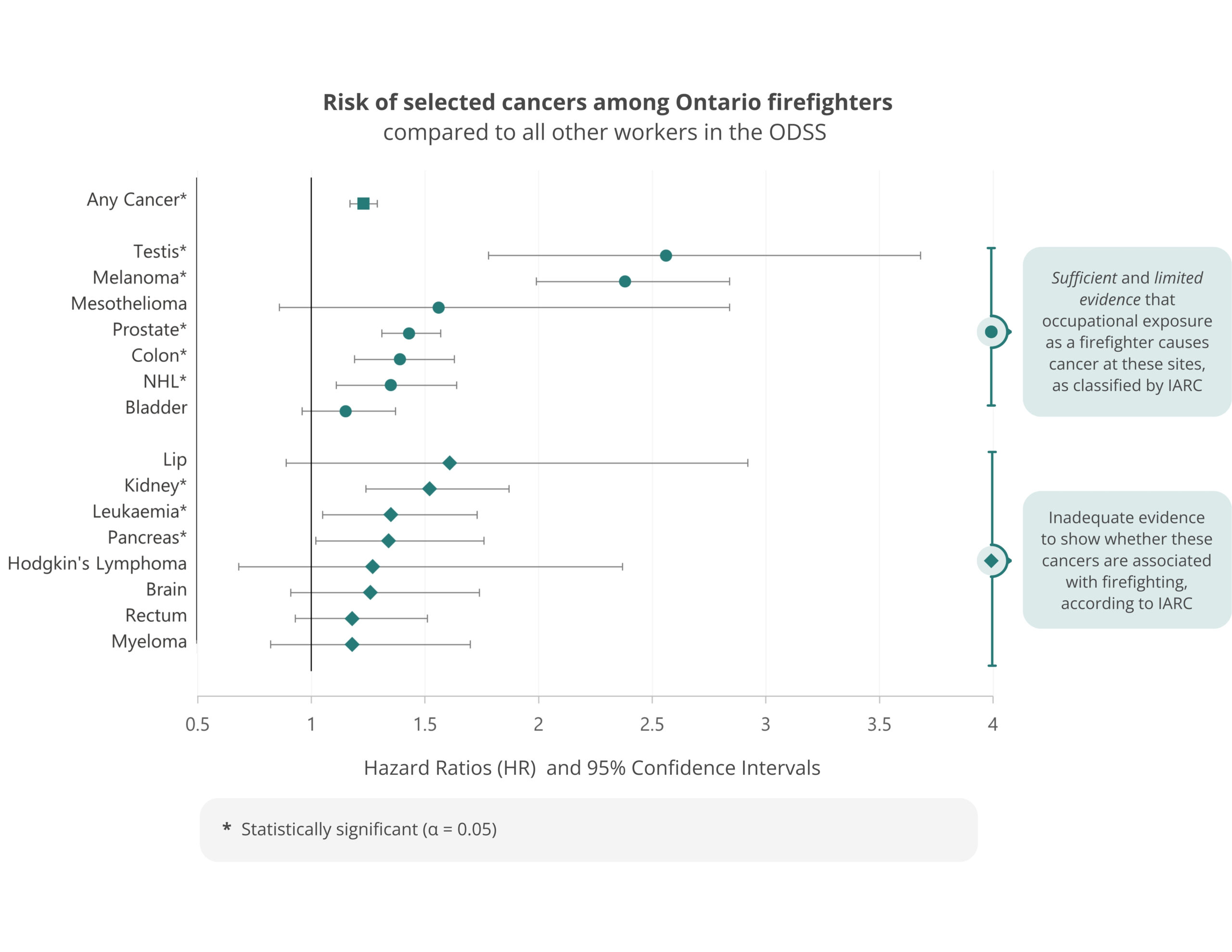Flames and Risks: Firefighting Causes Cancer
Background
Firefighting is a complex and often dangerous occupation. Firefighters can work for many types of fire services (e.g., municipal, wildland/forest, aviation services, military, and Indigenous). They may work as career and/or volunteer firefighters. Firefighters can respond to many different emergency events, including fires (e.g., structural, wildland, vehicle), medical incidents, building collapses, and hazardous materials releases. These tasks can expose them to many different carcinogens [1].
According to the International Agency for Research on Cancer (IARC), occupational exposure as a firefighter is carcinogenic to humans (Group 1) [1]. There is sufficient evidence that firefighting causes mesothelioma and bladder cancer, and limited evidence that firefighting may cause prostate, colon, and testicular cancers, melanoma, and non-Hodgkin’s lymphoma (NHL) [1–3].

Cancer Risks Among Ontario Firefighters
The following disease risks are based on results from the Occupational Disease Surveillance System (ODSS), which contains health outcomes for over 2 million Ontario workers, including approximately 13,600 firefighters [4]. Overall, Ontario firefighters in the ODSS cohort have a 23% higher risk of developing any cancer, compared to all other workers in the ODSS. For more information on these results, read our publication: bit.ly/cancerriskemergencyworkers.

Hazardous Exposures Among Firefighters
Firefighters are exposed to cancer-causing hazards primarily through inhalation and skin absorption [1]. These hazards may include many different fire and non-fire related exposures, such as combustion by-products (e.g., particulate matter, polycyclic aromatic hydrocarbons (PAHs), metals), chemicals (e.g., perfluorooctanoic acid (PFOA) in firefighting foams and pentachlorophenol (PCP) in wood structures), asbestos, and diesel engine exhaust (DEE) [1]. Night shift work is another hazard because firefighters provide 24-hour protection.
The table below shows the selected cancers with elevated risks among Ontario firefighters in the ODSS, along with some of the known (sufficient evidence) and possible (limited evidence) risk factors that firefighters may encounter, as classified by IARC [5].
| Cancer Site | Risk Increase (%) from ODSS findings | Known Risk Factors | Possible Risk Factors |
| Testis | 156% | — |
|
| Melanoma | 138% |
|
— |
| Mesothelioma | 56% |
|
— |
| Prostate | 43% | — |
|
| Colon | 39% | — |
|
| Non-Hodgkin’s Lymphoma | 35% |
|
|
| Bladder | 15% |
|
|
| Lip | 61% | — |
|
| Kidney | 52% | — |
|
| Leukaemia | 35% |
|
|
| Rectum | 18% | — |
|
| Myeloma | 18% |
|
|
Note: Pancreatic cancer, Hodgkin’s lymphoma, and brain cancer were excluded from the table as IARC has not identified any known or possible risk factors relevant to firefighters.
Exposure Control and Prevention
Firefighters’ exposures have changed over time as their tasks and responsibilities have evolved. These changes are due to several factors including changes in technology (e.g., increases in electric vehicle fires), building materials, personal protective equipment, and increases in frequency and severity of wildfires [1].
Implementing comprehensive exposure reduction policies and practices can help reduce the risk of occupational disease. Specific policies and practices may vary depending on the tasks and type of firefighting but may include:
- proper use of personal protective equipment (PPE)
- following appropriate cleaning and decontamination procedures for PPE
- installing tailpipe exhaust system extractors in fire halls to reduce DEE exposure
- modifying shift scheduling practices and shift length
- locating command posts and camps in wildland areas with least smoke exposure practicable
- education and training on hazards and exposure prevention
- implementing medical surveillance programs (e.g., cancer screening programs) for early detection
In 2023, an Act to establish a national framework for the prevention and treatment of cancers linked to firefighting became law. It aims to raise awareness and improve access to cancer prevention and treatment for firefighters in Canada [6]. In Ontario, firefighters and fire investigators (excluding forest and wildland firefighters) may be eligible to receive presumption for a number of prescribed cancer sites, if they meet the minimum duration of employment requirements [7].
Further research is needed on firefighting-related exposures and how these exposures can best be reduced. Future research should focus on providing evidence to support primary prevention policies.
Resources
Due to the long-term risk of firefighting activities, the OCRC is actively involved in many firefighter research initiatives. Please visit our firefighter resources webpage for more information on research activities, collaborations and tools available to the firefighting community: www.occupationalcancer.ca/resources/ff-resources/.
References
[1] P. Demers, D. DeMarini, K. Fent, D. Glass, J. Hansen, O. Adetona, M. Andersen, L. Freeman, A. Caban-Martinez, R. Daniels, T. Driscoll, J. Goodrich, J. Graber, T. Kirkham, K. Kjaerheim, D. Kriebel, A. Long, L. Main, M. Oliveira, S. Peters, L. Teras, E. Watkins, J. Burgess, A. Stec, P. White, N. DeBono, L. Benbrahim-Tallaa, A. de Conti, F. Ghissassi, Y. Grosse, L. Stayner, E. Suonio, S. Viegas, R. Wedekind, P. Boucheron, B. Hosseini, J. Kim, H. Zahed, H. Mattock, F. Madia and M. Schubauer-Berigan, “Carcinogenicity of occupational exposure as a firefighter,” Lancet Oncol, vol. 23, no. 8, pp. 985-986, 2022.
[2] International Agency for Research on Cancer, “Occupational Exposure as a Firefighter: IARC Monographs on the Identification of Carcinogenic Hazards to Humans Volume 132,” Lyon, France, 2023.
[3] N. DeBono, R. Daniels, L. Freeman, J. Graber, J. Hansen, L. Teras, T. Driscoll, K. Kjaerheim, P. Demers, D. Glass, D. Kriebel, T. Kirkham, R. Wedekind, A. Filho, L. Stayner and M. Schubauer-Berigan, “Firefighting and Cancer: A Meta-analysis of Cohort Studies in the Context of Cancer Hazard Identification,” Saf Health Work, vol. 14, no. 2, pp. 141-152, 2023.
[4] J. Sritharan, T. Kirkham, J. MacLeod, N. Marjerrison, A. Lau, M. Dakouo, C. Logar-Henderson, T. Norzin, N. DeBono and P. Demers, “Cancer risk among firefighters and police in the Ontario workforce,” Occup Environ Med, vol. 79, pp. 533-539, 2022.
[5] International Agency for Research on Cancer, “List of classifications by cancer sites with sufficient or limited evidence in humans,” 2023. [Online]. Available: https://monographs.iarc.who.int/wp-content/uploads/2019/07/Classifications_by_cancer_site.pdf.
[6] Parliament of Canada, “C-224: An Act to establish a national framework for the prevention and treatment of cancers linked to firefighting,” 2023. [Online]. Available: https://www.parl.ca/legisinfo/en/bill/44-1/c-224.
[7] Workplace Safety and Insurance Board, “Cancers in Firefighters and Fire Investigators,” 2023. [Online]. Available: https://www.wsib.ca/en/operational-policy-manual/cancers-firefighters-and-fire-investigators .
The Occupational Disease Surveillance System (ODSS) Surveillance Alerts provide brief summaries of occupational exposures and disease risks across different industries and occupational groups. The aim of these alerts is to highlight new or emerging issues detected through occupational disease surveillance. At this time the ODSS includes workers from 1983-2014 and follows their health outcomes until 2016. This alert reflects only the diseases currently tracked within the ODSS. The system is updated and expanded on an ongoing basis.
More information about the ODSS including data sources, methods and the most recent results can be found at ODSP-OCRC.ca and OccDiseaseStats.ca.
